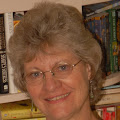 |
| Graphic by Elle Carter Neal |
There is no correct answer to that. I’ve read books that had one-page chapters, books with varied page-count chapters, and one book, Delores Claiborne by Stephen King, had NO chapters.
You can be arbitrary and make a chapter break every 10 (or 15 or 25) pages. But you really don’t need to set your book up in chapters to begin with (unless you’re a dyed-in-the-wool outliner). Sometimes, it’s easier to write the whole first draft with no chapters, just scene breaks, and do your chapter numbering later.
For me, as a writer, a chapter is a feel, a rhythm to a story. A chapter is a story within a story with a beginning, middle and an end. As a reader, I also like scene breaks within a chapter to change up that rhythm, and because we are now a society of short attention spans. We are accustomed to “sound bites”, tweets, and texts.
Break your chapter when your story needs a change of place, time, and or point of view.
For example: She shivered as she looked out the window at the snow drifts and debated throwing one more pair of shorts into her suitcase. NEW CHAPTER: The white-hot sun blinded her when she stepped out of the airport into the welcome warmth of Phoenix, Arizona. She breathed deeply and looked around her at the clear blue sky. Yes, she should’ve packed more shorts.
Break your chapter in the middle of the action to create more suspense (the cliffhanger), which will compel your reader to keep going.
Example: I stared in amazement at the unexpected and rather unnerving sight of the vehicle emerging from the mist—a hearse—a big, long, black hearse.
If you’re reading a murder mystery and the protagonist is in a small mountain town (Forbidden Entry by Sylvia Nobel), this will most likely make you turn the page to find out what that’s all about!
But use this technique sparingly. You don’t want to end every chapter this way, or even most of them. It becomes predictable and loses its punch, which is something you don’t want anybody to say about your novel.
How do you like your chapters to end and how do you decide how long they should be?
 |
| Heidi M. Thomas is a native Montanan who now lives in North-central Arizona where she blogs, teaches writing, and edits. Her first novel, Cowgirl Dreams, is based on her grandmother, and the sequel, Follow the Dream, won the national WILLA Award. The next book in the series, Dare to Dream, and a non-fiction book Cowgirl Up! A History of Rodeo Women, have recently been released. Heidi has a degree in journalism and a certificate in fiction writing. |



Shorter chapters (10-15 pages) encourage readers to read "just one more" and hooks at the end of chapters further encourage them to turn the page. I'm not a fan of one to two page "scenes." Every scene should contain conflict and move the plot forward. A short scene rarely adds anything useful and acts more as a speed bump. One sentence or paragraph on a page annoys me. I'm not talking about the end of the chapter that just happens to fall that way, but an actual one sentence or paragraph "scene."
ReplyDeleteA member of one of my RWA chapters once said, a chapter should be 'as long as a cat's tail' which is as long as it needs to be. My first draft of my first novel had almost all the chapters ending with a character driving away or going to sleep--the perfect cue for the reader to do the same.
ReplyDeleteI like to end my chapters with an incentive to turn the page and read more. This need not necessarily be a cliffhanger, but it does need, minimally, to pique the curiosity. Because my stories are layered and different characters with their own POVs are concurrently dealing with their traumas/dramas/issues, the next chapter may begin with another character in another place. (All the characters and/or situations are in some way interrelated.) The reader is never left hanging, however; I soon return to the first character's situation/plight and move that portion of the story on. It sounds more complicated than it is, and I haven't had any complaints from readers (so far).
ReplyDeleteI remember way, way back when romance writers were told to make their chapters a uniform 20 pages long. It was ridiculous. A chapter is as long or short as it needs to be.
ReplyDeleteI remember that, too. There were some strict rules back then as to the word count, chapter length and how many sex scenes were supposed to be in the story. I tried to write romance when they became so popular 30 years ago, but I found those rules/guidelines too strict.
DeleteTony Hillerman must be great at those keep-em-reading chapter endings. My husband is reading the Leaphorn series now and CANNOT close the book without finishing. Unheard of practice for this man. I must go analyze those books!
ReplyDeleteTony Hillerman's books are great. I love his style and his stories.
DeleteHeidi, I am like you in that the chapter breaks come when needed for the rhythm of the story. My mysteries tend to have shorted chapters that end with a bit of a cliff-hanger.
ReplyDeleteWe should look at Hillerman's chapter endings, Dani! What a great testament that your husband wants to keep reading. BTW, Anne HIllerman is continuing the series with a female protag and I think she's doing a good job of keeping that Hillerman flavor.
ReplyDelete